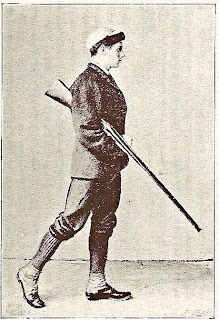
I belong to a club of around 40 people who shoot clay pigeons with all sorts and sizes of shotguns. Not just any shotguns, mind you, they have to be both of British make, and old enough to be historical. Most club members also fulfill these criteria, ever since the only young, Moslem member left a few years ago. When I joined some years ago, I substantially lowered the average age of the club, despite being about 50 years old at the time.
The membership is made up from all walks of life, and includes plumbers, dentists, engineers, lawyers, potato merchants, antique dealers, RAF officers and factory owners, though I would say over half of them are retired. Some are true countrymen, and others merely dress like one - and one from the mid-eighteenth century to boot.
The guns used vary between pea-shooter sized, 9mm 'garden guns' which you could fire indoors without deafening yourself, to six-foot long, 4 bore monsters that are about the biggest thing you can put to your shoulder, pull the trigger, and still remain in an upright position. Black powder is the preferred explosive, and the percussion-cap and flint is the favoured method of ignition, though I stubbornly refuse to keep gunpowder in the house, so all my guns are breech-loading, nitro-proof, 'modern' things of about 100 - 150 years old. One member owns a gun which started out as a match-lock, then was converted to a flint-lock when the new-fangled technology came out. On the barrel is engraved an inscription which tells that the gun was present at Tilbury Dock, when Queen Elizabeth the 1st made her 'Heart of a Man' speech, and I have actually seen him hit clays with it. I have also seen him hit clays with a reproduction match-lock too, and he maybe the only person in the world to have done so within the last 300 years.
To understand how impressive this feat is, you have to know how a match-lock works, which is an extremely easy notion to grasp. A modern shotgun cartridge is detonated by a small, centre-fire cap in the base of it, which is struck by a pin when the trigger is pulled, and the effect is instantaneous. A muzzle-loading, percussion gun is detonated by a metal cap - filled with dangerous, impact sensitive explosive - placed over a nipple which is above the main charge in the barrel, and the effect is almost as instantaneous as nitro, when the hammer falls on it. A flintlock is a piece of flint housed in a hammer which strikes the 'frizzon' (which is where we get that name from!) over a pan of fine, black powder ('flash in the pan' is a miss-fire) which is beside a hole which leads to the main charge in the barrel, and the effect - though quick - is delayed by about half a second, which seems like about two seconds whilst you wait for the huge flash about 8 inches away from your eyeballs, trying not to close your eyes.
A match-lock - as the name suggests - is no more than a short length of smouldering rope, attached to the end of a lever which you guide down onto the primed pan by gently pulling on a 'trigger' which is about 3 inches long, and pivoted in the middle. You then wait for the gun to decide when it wants to go off, and this can be from around 2 seconds to - in one case - about 3 minutes, long after it had been put back on the rack as a non starter. When you consider that - when shooting at clays or birds - the gun has to be moving continuously in front of the target, and the 'window of opportunity' may be around 4 seconds in duration if you're lucky, then you will understand what a feat this really is.
A few years ago, the club's beloved, honorary president died at a very old age. He was an absolute master at making miniature, working, muzzle-loading guns which were (and still are) exquisite in their detail and craftsmanship.
His family decided that - following his cremation - they wanted his ashes to be shot from guns, over a field, and evidently he didn't mind the idea either. The day came, and the entire family stood at a safe distance whilst about 35 of us lined up with single and double-barreled guns, and began inserting cartridges loaded with black powder and pulverised old-man into the breeches. Upon a given order, one end of the line began firing one barrel at a time, so the the volley was prolonged and sustained as it progressed in order. The bangs where accompanied by a great deal of smoke, which made it difficult to see what was actually going on.
Well, as I'm sure you've guessed, we were firing into a strong wind, and by the time we finished, we were white with dust from head to foot. Some of us went home singing, "I'm going to wash that man right out of my hair..."
It has to be one of the most surreal experiences of my life, when I shook hands with the grateful and aged widow afterwards as we all did, covered in what was left of her husband, looking like an old-fashioned miller from the days of Chaucer.
I suppose it's the thought that counts, but the old boy got spread a lot further than that small field over the following few days, and I'm sure bits of him were buried at sea.
No comments:
Post a Comment